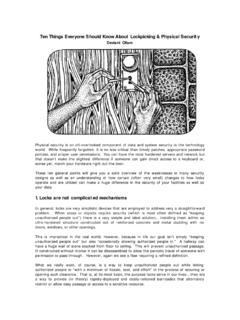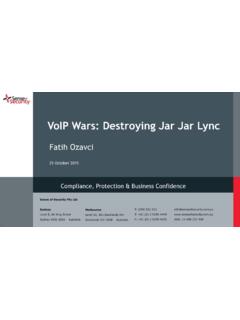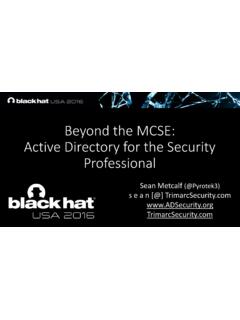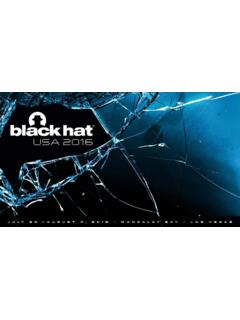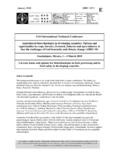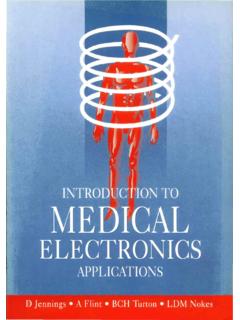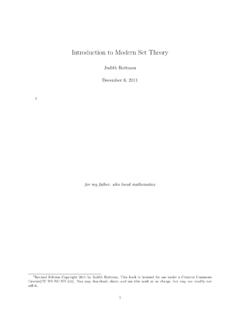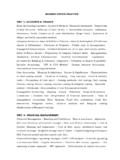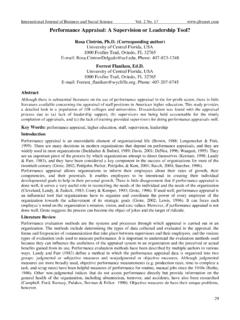Transcription of LDAP Injection & Blind LDAP Injection - Black Hat
1 INFORM TICA 64 ldap Injection & Blind ldap Injection In Web applications Authors: Chema Alonso, Rodolfo Bord n, Antonio Guzm n y Marta Beltr n Speakers: Chema Alonso & Jos Parada Gimeno Abstract. ldap Services are a key component in companies. The information stored in them is used for corporate applications . If one of these applications accepts input from a client and execute it without first validating it, attackers have the potential to execute their own queries and thereby extract sensitive information from the ldap directory. In this paper a deep analysis of the ldap Injection techniques is presented including Blind attacks.
2 ldap Injection & Blind ldap Injection Page: 1 of 17 Index Section Page 1. Introduction 02 2. ldap Overview 02 3. Common ldap environments 03 4. ldap Injection in Web applications 04 AND ldap Injection 06 Example 1: Access Control Bypass 06 Example 2: Elevation of Privileges 07 OR ldap Injection 08 Example 1: Information Disclosure 09 5. Blind ldap Injection 10 AND Blind ldap Injection 10 OR Blind ldap Injection 11 Exploitation Example 11 Discovering Attibutes 11 Booleanization 13 Charset Reduction 15 6. Securing applications against Blind ldap Injection & ldap Injection attacks 16 7.
3 References 16 Greetings: RoMaNSoFt, Palako, Raul@Apache, Al Cutter, Mandingo, Chico Maravillas, Alejandro Mart n, Dani Kachakil, Pedro Laguna, Silverhack, Rub n Alonso, David Cervig n, Marty Wilson, Inmaculada Bravo & S@m Pikesley ldap Injection & Blind ldap Injection Page: 2 of 17 1. Introduction The amount of data stored in organizational databases has increased rapidly in recent years due to the rapid advancement of information technologies. A high percentage of these data is sensitive, private and critical to the organizations, their clients and partners. Therefore, databases are usually installed behind internal firewalls, protected with intrusion detection mechanisms and accessed only by applications .
4 To access a database, users have to connect to one of these applications and submit queries through them to the database. The threat to databases arises when these applications do not behave properly and construct these queries without sanitizing user inputs first. Over 50% of web application vulnerabilities are input validation related, which allows the exploitation of code Injection techniques. These attacks have proliferated in recent years causing severe security problems in systems and applications . The SQL Injection techniques are the most widely used and studied but there are other Injection techniques associated with other languages or protocols such as XPath or ldap .
5 Preventing the consequences of these kinds of attacks, lies in studying the different code Injection possibilities and in making them public and well known for all programmers and administrators. In this paper the ldap Injection techniques are analyzed in depth, because all the web applications based on ldap trees might be vulnerable to these kinds of attacks. The key to exploiting Injection techniques with ldap is to manipulate the filters used to search in the directory services. Using these techniques, an attacker may obtain direct access to the database underlying an ldap tree, and thereby to important corporate information.
6 This can be even more critical because the security of many applications and services relies on single sign-on environments based on ldap directories. Although the vulnerabilities that lead to these consequences are easy to understand and fix, they persist because of the lack of information about these attacks and their effects. Though previous references to the exploitation of this kind of vulnerability exist the presented techniques don t apply to the vast majority of modern ldap service implementations. The main contribution of this paper is the presentation and deep analysis of new ldap Injection techniques which can be used to exploit these vulnerabilities.
7 This paper is organized as follows: sections 2 and 3 explain the ldap fundamentals needed to understand the techniques presented in the following sections. Section 4 presents the two typical environments where ldap Injection techniques can be used and exemplify these techniques with illustrative cases. Section 5 describes how Blind ldap Injection attacks can be done with more examples. Finally, in Section 6, some recommendations for securing systems against this kind of attack are given. 2. ldap Overview The Lightweight Directory Access Protocol is a protocol for querying and modifying directory services running over TCP/IP.
8 The most widely used implementations of ldap services are Microsoft ADAM (Active Directory Application Mode) and OpenLDAP. ldap Injection & Blind ldap Injection Page: 3 of 17 ldap directory services are software applications that store and organize information sharing certain common attributes; the information is structured based on a tree of directory entries, and the server provides powerful browsing and search capabilities, etcetera. ldap is object-oriented, therefore every entry in an ldap directory services is an instance of an object and must correspond to the rules fixed for the attributes of that object.
9 Due to the hierarchical nature of ldap directory services read-based queries are optimized to the detriment of write-based queries. ldap is also based on the client/server model. The most frequent operation is to search for directory entries using filters. Clients send queries to the server and the server responds with the directory entries matching these filters. ldap filters are defined in the RFC 4515. The structure of these filters can be summarized as: Filter = ( filtercomp ) Filtercomp = and / or / not / item And = & filterlist Or = |filterlist Not = ! filter Filterlist = 1*filter Item= simple / present / substring Simple = attr filtertype assertionvalue Filtertype = = / ~ = / >= / <= Present = attr = * Substring = attr = [initial] * [final] Initial = assertionvalue Final = assertionvalue All filters must be in brackets, only a reduced set of logical (AND, OR and NOT) and relational (=,>=,<=,~=) operators are available to construct them.
10 The special character * can be used to replace one or more characters in the construction of the filters. Apart from being logic operators, RFC 4256 allows the use of the following standalone symbols as two special constants: - (&) -> Absolute TRUE - (|) -> Absolute FALSE 3. Common ldap environments ldap services are a key component for the daily operation in many companies and institutions. Directory Services such as Microsoft Active Directory, Novell E-Directory and RedHat Directory Services are based on the ldap protocol. But there are other applications and services taking advantage of the ldap services. These applications and services used to require different directories (with separate authentication) to work.


